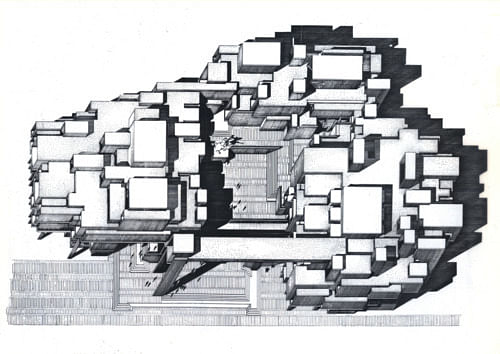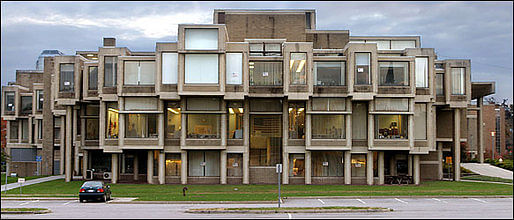
For the latest edition of the ShowCase feature, Archinect profiled 253 Pacific Street, a project designed James Cleary Architecture. It is a newly constructed building in Brooklyn, New York containing three duplex residences.

News
Planetizen covered Arup’s proposal for a "smart" building that will plug into "smart" urban infrastructure and cater to an increasingly dense and technology-savvy urban population. Fred Scharmen thought the proposal featured "Fantastic graphics" yet toasteroven continued his criticism from last week "I'm a little perplexed by this proposal - one the one hand it assembles all the ideas into one building (which should be larger city-wide infrastructure, not in a single building), but it's a little too ‘plug-in city’ for me - as in verging on completely unrealistic and incredibly naive about how the city really functions".

Apparently Ryan Griffin agreed, referring to the title of the news posting he wrote "radical? maybe helpful to post in a public forum to educate people about possible green technologies but as far as the design is concerned it doesn't amount to much more than a checklist".
Curbed announced that the Gerald B. and Beverley Tonkens House, designed by the legendary architect Frank Lloyd Wright in 1955 and listed on the National Register of Historic Places in 1991, was put up for sale for the first time ever this week. The asking price, $1.788M. Donna Sink opined "Honestly, I like FLW, but the views out of the kitchen and bedroom really are jail-like in this house. If I owned a FLW house I would damn well change the FFE to what I wanted! No major exterior changes, and nothing too unsympathetic. But I'm also averse to interiors that are overbearing stylistic gesamptkunstwerks” but Clint added "You see prison, I see fortress. One keeps you in, the other is security for the inhabitants. As to vines and painting, powerwashing, etc. stewardship carries a price beyond aquistion...It is simple, if you wish to be the steward, accept it for what it is. If you cannot, do not".
The Times Herald-Record reported that Paul Rudolph’s Orange County Government Center will be saved, as last week legislators approved a $10M bond to pay for the renovation of the 43-year-old complex. Some Archinector’s such as Apurimac believed this was "Excellent news!" others like Keyword noted cryptically "ah, the faux-old's grandchildren hard at work. Soon their offspring will be preserving morphosis".


Firms/Blogs/Work Updates
Prompted, "by a friend... a colleague who also manages a practice in Brooklyn", Mitch McEwen wrote a manifesto in 60 - 80 words. tman denounced the manifesto "The Manifesto is an outmoded way of thinking. Get away with what you can. References are he-said, she-said".
Over at his blog A Wild Cadence , Matthew Geldin asked the question "how can a building, a public node, or an entire city facilitate this new layering of activity and blurring of physical/digital experience? ...In the comments, lets discuss what inspiring spaces you have seen that innovate within this burgeoning paradigm. And how can our ability to seamlessly document and present our lives add value to human experience in the public realm?”. In response Orhan Ayyüce suggested "Maybe it all comes down to need to tell a story".
Edgar Markosyan currently enrolled at Woodbury University, recently worked on his Degree Project.

gwharton penned An Introductory Rant Against Inspiration in which he ‘cites’ the great Calvin and Hobbes and argues "Which is a roundabout way of saying that contemporary architectural theory is a solipsistic mess: mostly self-indulgent nonsense with pretensions to rigor. This is not to say that theory can be safely dismissed in our search for creative productivity in practice. It is to underline its importance. A tool can be used much more powerfully when the user understands what it can do and how". gwharton then followed up with a post wherein they parse the defintion of Creativity and its Instrumentalities.
Schools/Blogs
To address the urgent need for better models of urban growth, the MIT School of Architecture + Planning is launching a major new research center focused on the planning, design, construction and retrofitting of urban environments for the 21st century. Under the leadership of center director Alexander D’Hooghe and research director Alan Berger – the Center for Advanced Urbanism will coordinate collaborations among existing efforts in the School and with other MIT groups, as well as undertaking new projects at the Institute and with sponsors in practice.
toasteroven commented "@orhan - this has been in the air in Boston for some time. glad MIT is finally taking this up in a serious manner - I just hope they utilize the wealth of existing experience, info, and work that is already in place among numerous non-profits in the area".
NKI+ started a new blog revealingly titled, Masters of Architecture - Journal which will chronicle a “journey through a Masters of Architecture".
Lian Chikako Chang at Harvard GSD, has finished her thesis but still has a few classes to wrap up this semester. One, is a seminar with Rahul Mehrotra on the "Kinetic City", in which "Prof. Mehrotra argues that we shouldn't talk about the 'informal' in urban spaces because this notion sets up a false binary between 'formal' and 'informal,' and it's not as if 'informal' spaces don't have a form. So he proposes the notion of a 'Kinetic City' instead, that looks at ephemerality and change over time. It's a research seminar with a series of case studies. The central case study, occupying about 1/3 of the class, is a study of the Kumbh Mela".
However her "case study is a bit different, and will look at some aspect--not sure yet--related to the internment of Japanese Canadians in WWII".
Over at their College of Architecture at Georgia Tech blog, fschlem continues to document the work from Dirty South Studio. For Kasia Zycinska, the research led her "to design the ‘average’ Atlanta home".

Discussions
fullofit restarted the thread You got a firm? Are ya makin' it? with the explanation/question "Bump because this was a great thread and I want to hear about how things may have changed since 2008. I'm sitting in a cafe studying for the AREs pretending that reading this counts as studying. Work is slow at my firm right now so this seemed like a good time to start testing, but the main thing driving me is the idea of starting a firm in a couple of years. On a side note, any of you all doing small development on the side as well? It seems like a scary thing to start, but the control of your work and chance to make money are pretty big incentives”?
hys316 chimed in "You need large capital for development, otherwise you will just be doing it for the bank if you are hoping to take out a large loan. Having said that, this is my goal as well, to one day do my own development”.
while Gregory Walker "we've been up and running for 8 years now. and, finally (finally) it feels like we're starting to turn a corner..so, we're... poised. and, i'll say for myself, i'm as equally excited/intrigued/entrenched in the design of our practice, as i am about the projects we're doing and the clients we're working with. just focusing on providing that framework and team chemistry".
Curious at seeing the additions and a few new builds going up in their city, Jefferson wanted to get tips on Getting new work. The first few comments were mostly snark but quizzical helpfully answered "To get work you've got to find ways to position yourself so potential clients know who you are, have respect for what you have accomplished, and can learn to be comfortable with who you are as a person. There is no ‘easy button’ for making this happen" and archie offered 13 things that the OP could do including; "advertise in local inexpensive newsletters, join some activity, club etc where lots of local homeowners hang out, establish an identity on Houzz, and have a very good web page that appeals to home owners".
sameolddoctor wanted to know "Why has someone not mentioned the AIA yet ?”
Finally, olsen415 is a grad student at the University of Minnesota doing their thesis project on the Gowanus Canal out in Brooklyn and wondering if anyone has a copy "of the Climate Change Adaptation in New York City: Building a Risk Management Response. Also been looking for some sort of comprehensive bathymetry data on the NY harbor. Trying to get a better handle on some of the stuff happening subsurface”. In response Rusty! griped "Gowanus Canal and Domino Sugar Factory is to architecture students what shit is to flies. Have you tried googling for that report? It's free online. You have to spell NYC correctly though".
Additionally
Bruce Sterling provided a handy "Convinced Rating" for each of Adam Greenfield recent 100 propositions, to be found in his in-development book, (The City Is Here For You To Use) re: the intersection of emerging networked information technologies with urban place.
No Comments
Block this user
Are you sure you want to block this user and hide all related comments throughout the site?
Archinect
This is your first comment on Archinect. Your comment will be visible once approved.